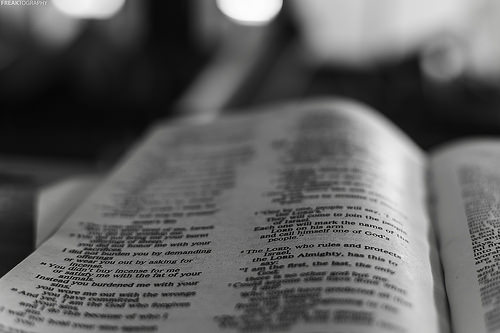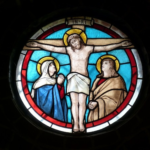We run our website the way we wished the whole internet worked: we provide high quality original content with no ads. We are funded solely by your direct support. Please consider supporting this project.

The Bible is Infallible NOT Inerrant
While the cruciform understanding (explained here) of the “God-breathed” nature of Scripture is in tension with the way most talk about inerrancy (See previous post on inerrancy), I do not believe it is at all incompatible with what the Church has always sought to express by affirming the “infallibility” the Scripture. The core conviction is that Scripture will not fail you when you rely on it for the purpose for which it was intended. Even ancient thinkers such as Origen and Augustine understood that one can find mistakes in Scripture if you hold it to the wrong criteria. While “infallible” must be more precisely defined, it does not require us to use modern scientific and historical criteria to evaluate Scripture as does the word “inerrancy.”
I believe the word “infallible” succinctly captures the attitude of Jesus and the earliest disciples regarding Scripture. Moreover, while the concept of inerrancy is inapplicable to certain genres within Scripture (e.g. how does one affirm a poem or a song to be inerrant?), the concept of infallibility is broad enough to be applied to any genre of literature. Whatever purpose an author had for composing whatever kind of canonical literature we might consider, we may affirm that, because it is “God-breathed,” this writing will not fail to achieve its purpose, assuming, once again, that we are relying on it for that purpose instead of for the purpose of satisfying our epistemic angst or some other imported agenda.
Most fundamentally, if we affirm that everything about Scripture, including its “God-breathed” nature, should be understood in light of the cross, then we are led to accept that Scripture’s infallibility should be understood in terms of the cross. While I can imagine a way of coherently reconceiving inerrancy in a cruciform fashion, I confess it sounds awkward to me, almost suggesting that not committing an error was central to what the Incarnation and Crucifixion was all about. While the historic-orthodox faith has always confessed Jesus’ sinlessness, the suggestion that the boy Jesus didn’t have to learn by making mistakes as he grew up is Docetism at its worst. “Son though he was,” the author of Hebrews tells us, “he learned obedience from what he suffered (Heb 5:8). Yet, while he made mistakes, suffered from them and learned obedience, Jesus never failed to faithfully bear witness to his Father. And for the same reason, when we approach Scripture with the purpose of discerning the crucified Christ in it, it seems perfectly natural to speak of Scripture never failing to bear witness to the crucified Christ, even when it is by certain standards mistaken.
From my perspective, the reason why the language of “infallibility” sounds much more appropriate in capturing the trustworthiness of Scripture is that it is much more at home in the language of covenant relationships (i.e., covenant-making and covenant-keeping). The concept of inerrancy seems more at home in fields of discourse in which getting things exactly right is a highest priority. It feels natural for scientists engaging in a laboratory experiment, or for scholars compiling a lexicon, or for sociologists compiling statistical reports to speak about committing no errors. But while I can imagine a covenant that includes as part of its terms the promise to never make an error, this is quite out of place in the real world of covenant-making and especially in the discourse surrounding biblical covenants. In the language of biblical covenants, one promises to place their trust in the trustworthy character of their covenant partner, and one promises to cultivate a trustworthy character in relation to their covenant partner. This, in fact, is what the biblical concept of “faith” is all about.
Image by Freaktography via Flickr.
Category: General
Tags: Bible, Bible Interpretation, Covenant, Cruciform Theology, Faith, Inerrancy, Infallibility
Topics: Biblical Interpretation
Related Reading

God’s Love is Cruciform
Paul instructs us in what it means to follow Jesus, when he stated, “Follow God’s example, therefore, as dearly loved children and walk in the way of love, just as Christ loved us and gave himself up for us as a fragrant offering and sacrifice to God (Eph 5:1-2). Here Paul defines what it means to…

Violence: What Did Jesus Do?
Thomas Quine via Compfight Here’s a spot-on reflection on what Jesus taught us about responding to violence. Whatever you think about the justification of violence in particular situations, as Christians we simply cannot escape the fact that Jesus demonstrated another way. From the reflection: And though he had access to unlimited power to have himself released…

Is There an Actual Satan?
Roger Olson wrote an excellent piece on how contemporary Christianity has tended to ignore or altogether extract Satan from the Biblical text. He explores some of the possible reasons for it and also discusses his own journey as he wrestled with the belief in the demonic realm. Really interesting. Here’s a personal experience of the…

Changing Beliefs
Stephen Mattson is a follower of ReKnew and a member of Woodland Hills Church who posted a piece on Sojourners titled Christians: It’s NOT a Sin to Change Your Beliefs. He points out that doubt and questions are a natural and needed part of any Christian’s life, and our community needs to change the ways we…

Gungor and Doubt
Gungor is working through the issue of doubt on their new album. (Thanks Orlando for the heads-up.) We’re busily getting ready for the Faith, Doubt & the Idol of Certainty conference tomorrow. It’s not too late to join us. Hope to see you there.

The God Who Embraces Our Doubt
Lawrence OP via Compfight Zack Hunt over at The American Jesus posted some of his thoughts on doubt, and it seemed fitting on this week before the Doubt, Faith & the Idol of Certainty conference to share what he had to say. We’re thinking he must have stumbled on Greg’s book or maybe God is…
